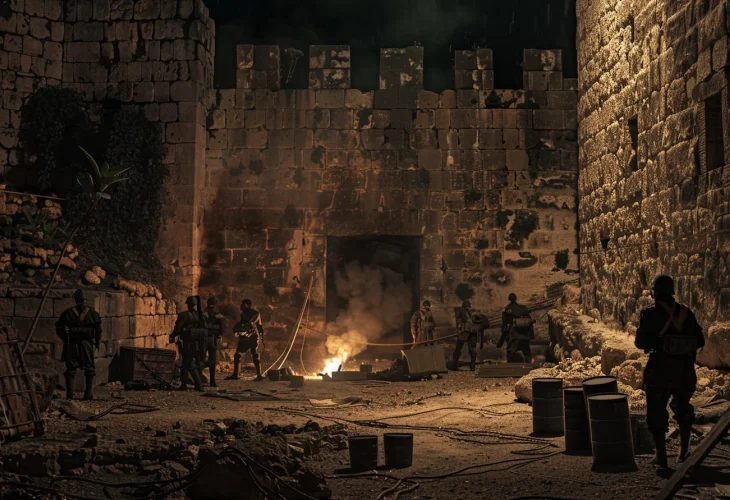History and Archaeology
Breaking Free from Acre Fortress: A Story of Resistance
Discover the true story of the underground escape from Acre Fortress that shocked the British and stirred deep controversy in the Jewish community

A few decades ago, understanding of mental health was limited. Anyone with emotional or psychological struggles was often labeled "crazy" and sent to what was then called a "madhouse." These institutions resembled prisons more than places of care. The conditions were harsh and even frightening and neglect, violence, and mistreatment were all too common.
One such place was in the ancient city of Acre (Akko). In the northern part of the city, near the wall, stood a massive stone fortress. Originally built by the Crusader order of the Hospitallers nearly 900 years ago, it sat between the sea and a deep moat, its foundations resting on arched, fortified basements. The Mamluks fought fiercely to conquer it 200 years later, and throughout the Ottoman period, it served as a Muslim stronghold. But in modern times, under British control, this fortress became infamous not as a military post, but as a place of despair.
After World War I, when the British ruled the Land of Israel, they converted the fortress into a prison. Over time, many of the prisoners were Jews from underground resistance movements, especially the right-wing Irgun. In 1920, Ze’ev Jabotinsky, founder of the Revisionist movement, was imprisoned there after defending Jews during riots in Jerusalem. Other prisoners included fighters from various Jewish underground groups, as well as Arab terrorists. The prison included gallows and nine Jews were hanged there by the British.
The British authorities treated Jewish underground prisoners with cruelty: medical neglect, harsh interrogations, and degrading punishments. Trials were often unfair, and death sentences were handed down quickly. The undergrounds made repeated efforts to rescue those inside.
Amichai Paglin, a senior member of the Irgun, spent weeks walking the alleys of Acre, closely studying the layout. Disguised perfectly as an Arab and fluent in Arabic, he drew no suspicion. Using his reports, a detailed and daring escape plan was created. It required months of preparation, including smuggling tools and coordinating teams across the country.
The plan went into action on Sunday, May 4, 1947. A group of 34 Irgun fighters blocked the Haifa–Nahariya road, set gas stations on fire, and created chaos to prevent British reinforcements. They dressed as British soldiers and used British vehicles to confuse everyone.
Meanwhile, another Irgun unit entered a Turkish bathhouse near the prison, disguised as telephone repairmen. From there, they blew a hole in the prison wall. At the same time, Jewish prisoners inside blew open an internal gate using explosives smuggled in inside cans of food. They delayed the guards with stun grenades and burning barricades.
Forty-one underground prisoners escaped. They scattered across the city using pre-planned escape routes. Some were injured or captured, but 27 made it to freedom. Three of the captured escapees were sentenced to death.
In response, the undergrounds kidnapped two British sergeants and warned that if the three Jews were executed, the sergeants would face the same fate. The British ignored the threat and executed Meir Nakar, Avshalom Haviv, and Yaakov Weiss. That same day, the two British sergeants were found hanged in a grove near Netanya, now known as “The Sergeants' Grove.”
The British reacted with brutal punishments, including public lashings. In response, Irgun fighters captured British soldiers and whipped them in the same manner. These actions shocked the British and weakened their will to continue ruling over the Jews in the Land of Israel.
While members of the underground took great pride in the operation, leaders of the Mapai movement (which later became the Labor party) distanced themselves. The very next day, the Jewish Agency’s spokesperson condemned the operation as “irresponsible and reckless,” saying that the attackers lost 15 men and even released Arab criminals, some of whom had Jewish blood on their hands. Hashomer Hatzair kibbutzim refused to bury the Irgun fighters in their cemeteries.
In an effort to erase the memory of the breakout, the authorities repurposed the Acre fortress as a mental institution, a place no one wanted to visit. But over time, people began to recognize that even if there was debate over methods, there was no doubt that the Jewish underground played a vital role in ending British rule, which had clearly favored the Arabs. These efforts helped pave the way for the peace and freedom the Jewish people hoped and prayed for.
Ach Tov VaChesed – Daily Halacha

